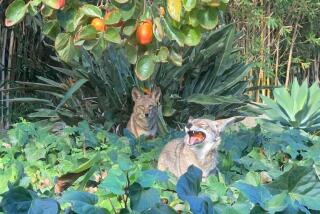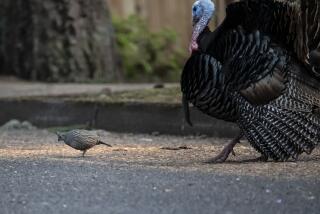Where peafowl don’t run afoul
- Share via
It’s just before sunset, and the peafowl of Victor Heights are preening along Marview Avenue, as they do almost every evening.
Long tails fanning out behind them, the birds perch atop city-issued recycling bins at one house. They leap to the roof of a one-story ranch-style home next door. They tilt their heads, shaking them slightly.
But more than anything, they appear to be taking in the stunning vista of the downtown skyline stretching out before them.
Peacocks and peahens have been unwelcome intruders for decades in many parts of Southern California. La Canada-Flintridge debated trapping them. In Palos Verdes, someone poisoned them. Ventura County rounded up nearly three dozen near the Santa Susana Pass and took them to a wildlife refuge 20 miles away
But life for the birds is different in Victor Heights.
Residents in this working-class section of L.A. west of Chinatown treat the peafowl like just another neighbor, albeit a noisy, disruptive and temperamental one. The few thousand humans who live here have grown to accept the birds’ 4 a.m. squawking, their trampling of plants and flowers and their oversized eggs occasionally left on porches to hatch.
“You come to get used to them,” said Clay Bush, who moved to Victor Heights in 2000.
At times, neighbors are acutely aware that the birds live in their midst. To avoid hitting them, drivers make sure to maneuver slowly on the area’s steep hills. Children collect their feathers. And almost everyone seems to love watching their bizarre mating dance -- often performed in the middle of the street -- in which a male, feathers fully extended, sashays sideways toward his beloved.
Victor Heights is a collection of stuccoed apartment buildings and faded bungalows, a place with a lot of old-timers who consider themselves the birds’ protectors. But none are foolish enough to call themselves the owners of these stubborn, independent-minded fowl.
Take Dennis Phipps, who has lived here for 30 years and whose house is marked by a panel decorated with the silhouettes of four peacocks, their tails extended in a blaze of feathers.
“One thing I need to make perfectly clear to you,” said Phipps, 71. “They kind of adopted me. I am known in the neighborhood as the peacock man. But they are not my peacocks. I do not claim ownership to them.”
Phipps can time the seasons by the birds’ activities. They lay their eggs on his awning in mid-May, and new peafowl chicks usually arrive around Father’s Day. By the end of summer, the chicks have learned to fly.
Though some residents say they have seen as many as 10 peafowl at one time, Phipps said, these days there are two adult males, an adult female and two younger females in Victor Heights.
Phipps said he typically sees the birds “three times a day: breakfast, lunch and dinner. I feed them. I spoil them. They like shelled peanuts, unsalted, and multi-fruit-flavored tidbits [like those fed] to exotic birds, like parrots. And of course, wild birdseed, dried cat food -- just about anything. They will also eat toast, toasted bread and different table crumbs.”
Indeed, residents have very specific ideas about what they serve the peafowl. Jerome Dueber, 63, believes human food doesn’t agree with them. He worries that dried bread might contain too much salt. So he serves up dry cat food, which he scatters by the handful on his driveway. “They really eat it up,” he said.
Dueber, who has lived with his son in a Victor Heights apartment for six years, said he is amazed by the birds’ audacity. “Sometimes they walk right up.” Neighborhood cats looking for a quick snack run in the other direction as the feathered creatures approach.
Like the neighborhood man who can always be found rocking on the front porch, the peafowl have their favorite perches. In the morning, the birds can usually be found on Everett Street; later in the day, they move a block east to Marview, where they find telephone poles or roofs to roost on. In between, they are hard to spot but easy to hear. They make their presence known with screeches that sound a lot like babies writhing in pain. As Dueber spoke, one bird’s shrieks echoed through the neighborhood.
But not even piercing noises and near-constant interruptions seem to faze Dueber and others from Victor Heights.
“They’re part of the neighborhood,” Dueber said. “They’re nice to have around, and they’re not hurting anybody.”
--
Victor Heights is a few minutes from downtown and offers dramatic views of the city center. But it’s far removed from the urban grid. Years ago, the area got the nickname “Forgotten Edge” because the LAPD couldn’t find the district when residents called to report crimes.
Long-timers say one reason the peafowl have been so accepted is because Victor Heights has embraced a live-and-let-live attitude. It’s got an only-in-L.A. demographic mix, with older Italians and Croatians who once dominated the area, newer Asian and Latino immigrants, a smattering of hipsters betting that Victor Heights will be the next big thing.
“There are a lot of characters here,” said Steven Rice, a reality television director who has lived in a home on White Knoll Drive for about 16 years.
One of the original characters was Charlie Ruiz, a collector of stray animals who was said to have introduced peafowl to the neighborhood nearly four decades ago .
Ruiz died in 1993, and his house later burned down. So the exact story of Ruiz and his birds remains wrapped in neighborhood lore.
Raymond Seizinger came to Victor Heights in 1949 as a young art student. Now 82, the retired landscape gardener is one of Victor Heights’ amateur historians. As Seizinger recalls, Ruiz was given a peahen by a sister or a cousin. “I can’t remember what the relationship was.”
Ruiz, he said, kept the bird in his backyard. “But it would get out. I saw her up in my pine tree in my backyard. She came to my front deck and sat on the front steps, looking out.”
All was well until mating season, when the peahen unleashed an ungodly racket, the high-pitched squeals of a bird in heat.
After enduring more episodes of the peahen-in-heat, another neighbor got a peacock, Seizinger said. The woman, he said, who was raising chickens in her own backyard, got the male from a supplier in the Inland Empire.
The two avians finally met up, Seizinger recalled, on a Christmas Eve morning. “And,” he explained, “we have had the peacocks ever since.”
In many ways, the birds have come to resemble their human neighbors.
They are creatures of habit, just like the Asian women who climb the neighborhood’s steep hills in the early morning, or the children who play in the streets in the afternoon.
And though the peafowl have long been the concern of Victor Heights’ older generation, they’ve found fans in newer arrivals as well.
Paul Jefferson, a 24-year-old landscape designer, recently moved to Victor Heights from Sun Valley. On his first day, his dog, Snoop, spotted five or six birds in their apartment building’s driveway.
Snoop, a miniature Doberman pinscher, growled a bit. His hair stood on end. Jefferson was intrigued too -- and now considers the birds one of the perks of the neighborhood.
“I fell in love with them,” Jefferson said. “It’s cool they can survive here.”
They have survived largely thanks to their human neighbors. Even though the peafowl can be a pain, said Monica Valencia, a spokeswoman for City Councilman Ed Reyes, neighbors have never asked the city to remove them.
“Some neighborhoods have their resident cat or dog,” Valencia said. “For Victor Heights, it’s the peacocks.”
--






